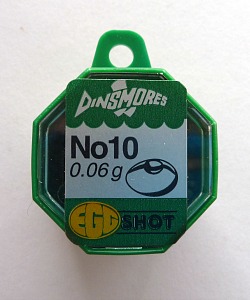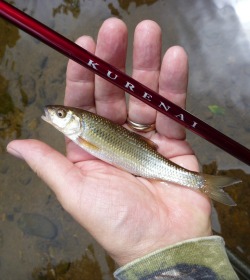Porcupine Quill Floats
Some time ago, a conversation about unusual fly tying materials started out with snake skin for the Mamushi Kebari. When I mentioned that the snake is venomous, the other tyer lost interest. Always trying to be helpful, I suggested roadkill as perhaps a safer way to acquire a snake skin. In return, he suggested that roadkill might be a safer way to acquire porcupine guard hairs, which make very nice quill bodies. As soon as he mentioned the words "porcupine" and "quill" I immediately thought of porcupine quills (simply amazing how the human mind works). I told him he could keep the guard hairs, but I would be interested in some quills.
Of course, since we were talking about fly tying, he assumed I was thinking of using the quills for fly bodies but I had already left fly tying and was well into micro fishing mode. Porcupine quills, I figured, ought to make really nice floats for micro fishing. The American porcupine's quills are bright white beyond the dark pointy tip. Bright white is easy to see when looking down against the dark surface of a lake or slow moving stream, but much harder to see when looking up at the sky (which has to be why nearly all baitfish have white bellies).
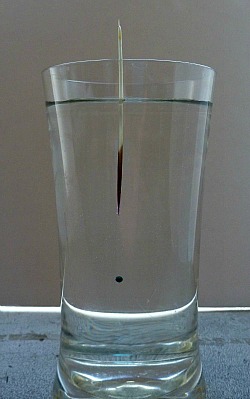
Porcupine quill floats are generally made from the quills of African porcupines. At up to 9 inches long (or more), the quills are huge compared to the quills of American porcupines, which are only 2 to 3 inches long. The floats are said to be quite sensitive.
It seems to me, though, that if you wanted a sensitive float, particularly one sensitive enough for micro fishing, you'd use the 2-3" American quills rather than the 7-9" African quills.
Curiosity piqued, I had to try one.
It turned out the guy I was talking to actually had some quills, which he graciously offered to send me. I don't know if they were from roadkill - he didn't volunteer the information and I didn't ask. I gratefully accepted and within a few days I had a little box full of porcupine quills (and yes, those suckers are SHARP).
Being so thin, floats made from American porcupine quills should be easy for even small micros to take under. It turns out that one #10 Dinsmore shot cocks a float made from one of the larger quills very nicely (at least it does in a glass of water).
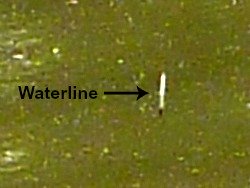
Unfortunately, my next scheduled fishing trip was not going to be a micro trip but a day out with my bass fishing-friend. I didn't let that stop me. Part of the day was devoted to a second attempt at two-handed casting with long keiryu rods, but part of the day was a "proof of concept" session with the porcupine quill floats.
It turned out to be a very interesting day and I learned a number of things. I learned that a porcupine quill float will suspend a Killer Bug quite nicely (without the Dinsmore #10 shot). I learned that sunfish will suck in a stationary Killer Bug, and that when it does the porcupine quill float reacts instantly - even with very small sunfish. I do believe that the porcupine quill float would be plenty sensitive enough for micros.
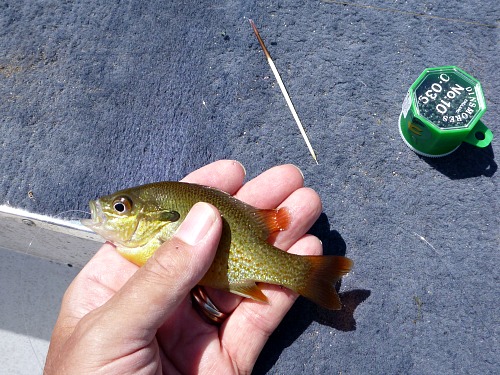
It should have come as no surprise, but I also learned that a porcupine quill float is incredibly
aerodynamic and will cast quite well
with a Nissin 450 SP
seiryu rod and a size 3 line. I am sure you could cast them very easily with any tenkara
rod or seiryu rod. In contrast, I think the curly mono indicators do not cast at all
well with tenkara rods, and to me the Thingamabobbers are even worse.
The Unibobbers are small enough that they aren't bad, but they aren't nearly as nice as the
porcupine quills. (Unibobbers have since been discontinued. The 3/8" Nakazima Ball Floats are essentially the same size as Unibobbers.)
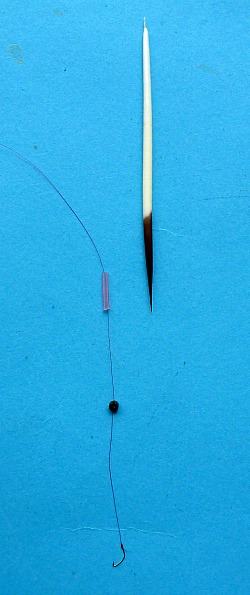
Tenkara anglers in Japan do not fish with floats. There is a traditional Japanese fly fishing method that did use floats (and still does to this day), but "tenkara" is defined to exclude it. Seiryu anglers in Japan do use floats. I know there are tenkara anglers in the US that use indicators (I often fish with a guy who does) and I have gotten questions from others. A float (indicator) that is easy to cast with a tenkara rod is something that will interest some anglers (and if you're one of them, do not be ashamed).
I have not yet tried the porcupine quill floats in a stream but I suspect they would work fine. With an unweighted wet fly or nymph and no split shot, the quill will lay on it's side but because of its color it should still be quite easy to see. I am sure trout see enough twigs floating down the stream that a quill on its side is not going to spook them like a Thingamabobber or big yarn indicator can.
When fishing a bead head nymph, you will have to use a very small fly with a very light bead to
avoid pulling the quill under. I do know from fishing in the lake that a
porcupine quill will suspend a Killer Bug tied on a size 12 Daiichi
1560. (I have had questions specifically on whether the Owner micro fishing floats
will suspend a Killer Bug.) You may have to try the water glass test
shown above with the bead head nymphs you use to see if the porcupine
quill will suspend them. Just the dynamics of the currents
within the stream may pull the float under from time to time, though. For fishing weighted nymphs in a stream, a porcupine quill float may be a little too sensitive.
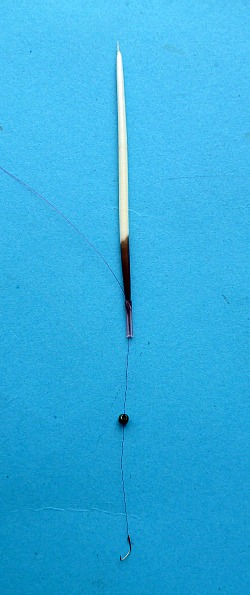
Rigging the float could not be easier. The line is run through a small piece of vinyl or PVC tubing. For a lake or slow stream, the length of line between the tubing and the hook should be about an inch shorter than the depth that you want the hook below the surface. For moving water the length of line between the tubing and hook should be a bit more than the desired depth. The water flow nearer the stream bottom is slower than at the surface because of the rocks etc. that disrupt and slow the flow, so the hook will trail behind the quill float as it is pulled through the slower water.
When you have the desired length of line between the tubing and the hook, insert the sharp, dark end of the quill into the tubing. Because of the microscopic barbs on the quill, it will stay in the tube and the tube will stay where you place it on the line. If you want to move it or when it comes time to take it off at the end of the day you will find that the quill can be pulled out of the tubing, but it is not easy.
I'm not an expert on floats or float fishing. I'm presenting the concept of porcupine quill floats with the smaller American porcupine quills for a few reasons. I think they'll work great for micro fishing. Tenkara anglers who do want to use indicators will find them to be much easier to cast than what they are using now. Finally, there's something about using a porcupine quill for a float that's kind of like using horsehair for a line. It just appeals to me (but it also works pretty nicely).
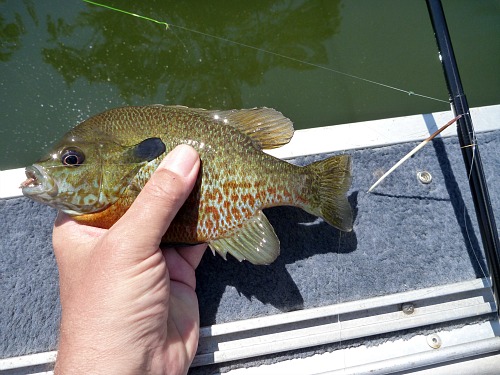
The only problem is that I haven't yet found a source for the thin vinyl or PVC tubing. The tubing I used for this test came from a package of the Owner tanago floats. I'm working on it.
Update
I have found a source for thin tubing and a source for more porcupine quills. There's more product testing to be done, but TenkaraBum brand Porcupine Quill Micro Fishing Floats may be on the horizon.
Update #2
I tried fishing with the porcupine quill floats in a fairly placid stream. I found it very hard to get the weight right. If I had enough to cock the float (get it to float vertically rather than on its side), it was pulled under just by current differentials between the surface current and the slower, swirling currents underneath the surface where the fly was. I later took off all the weight and fished with an unweighted wet fly and the quill laying on its side.
It did prove to be an easy point of reference to watch for line movement, and it did register the bite of this fallfish pretty easily, but I'm not sure it is enough more visible than just the end of the Hi-Vis line to make it worth messing with, especially when catching fish of this size. I think for still water or for very slow moving, placid streams, and for very small fish for which an extremely sensitive float is required, a quill float may make sense.
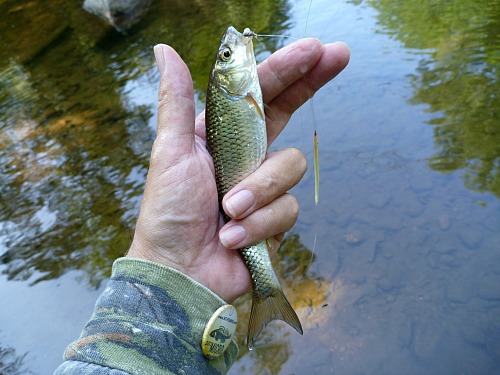
On the following day I received the porcupine quills I had ordered from an online seller and I must say I am quite disappointed. Of the 100+ quills I received, only a very few were large enough to support even a single #10 shot. The ones I had gotten from my friend were all larger than the largest of the commercially sourced quills. Unless a source for larger, more consistent quills exists, I may have to chalk this one up as an interesting idea that has no commercial merit.
Update #3
The Owner Micro Fishing Floats work very nicely and are not nearly as fussy to deal with as the porcupine quill floats. If you like DIY you may like playing with quill floats. If you just want to fish without frustration, I would suggest the Micro Fishing Floats.
TenkaraBum Home > Micro Fishing Floats > Porcupine Quill Floats
“The bitterness of poor quality remains long after the sweetness of low price is forgotten” - Benjamin Franklin
"Be sure in casting, that your fly fall first into the water, for if the line fall first, it scares or frightens the fish..." -
Col. Robert Venables 1662
As age slows my pace, I will become more like the heron.
Warning:
The hooks are sharp.
The coffee's hot.
The fish are slippery when wet.
Beware of the Dogma
What's in stock?
Suntech Tenkarakyo 40F Tenkara Rods
Suntech Kurenai II AR39F
Seiryu Rods
Coming Soon
Latest Pages
If you enjoy spin fishing or baitcasting please visit my sister site Finesse-Fishing.com.



